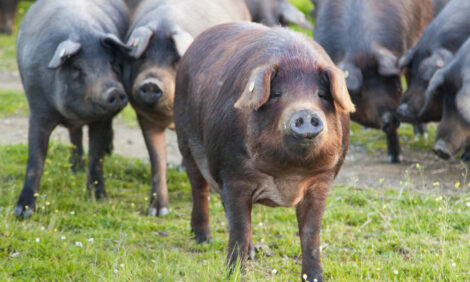



Pork Profits on the Horizon
US - Pork producers have begun the chant "four more months" as they can now see the light of profits as they are set to emerge from a tunnel of losses. That tunnel of darkness stretched from the spring of 2012 through the winter of 2013, with average estimated losses of $18 per head, primarily due to high feed prices.Feed prices reached a summit in the third quarter of 2012 with the peak of the drought. Estimated total hog production costs shot up $10 per live hundredweight, reaching an estimated $72. Costs last fall and this winter dropped about $4 per hundredweight and are expected to moderate an additional $8 with normal 2013 crop production. By fall that could put estimated costs of production around $60 per hundredweight.
The December Hogs and Pigs report from USDA provides evidence that 2013 pork supplies will not be down as much as the two percent that had been anticipated. Rather, pork supplies for the year may be closer to unchanged with a one-to-two percent reduction in the first-half offset by a one-to-two percent increase in the second-half of the year. The size of the breeding herd was unchanged as of December 1, 2012 when the expectation was that the herd had been reduced by at least one percent. In addition winter farrowing intentions are unchanged, compared to a two percent reported reduction in the previous inventory report. Market weights will also contribute to increasing pork supplies in the second-half of the year. First-half weights are expected to be down about one percent as long as feed prices remain high. But those weights will begin to rise late in the summer, assuming feed prices drop with more normal crop production.
Hog prices are expected to be somewhat stronger in 2013 due to small beef supplies, continued strong pork exports, and modestly improving consumer incomes. Live prices averaged about $62 in 2012, but are expected to rise to near $66 for 2013. Prices are expected to average near $63 in the first quarter, $71 in the second quarter, and $69 in the third quarter. Fall 2013 and winter 2014 prices are expected to reflect higher pork production with prices averaging around $61.
For the immediate future, losses will continue in the first quarter of 2013 and are expected to average about $15 per head. The return to profitability is expected to come in late-April or early-May when the spring hog price rally is underway and as meal prices edge lower with the South American soybean harvest. Profits are projected at about $10 per head for the second and third quarters before returning to breakeven in the fall of 2013 and winter of 2014. Breakeven means that producers cover all costs, including full labor costs and full depreciation on buildings and equipment.
With the return of a profitable pork production outlook, some producers will be discussing expansion plans. Most realize that the level of feed prices are both the biggest threat to those anticipated profits and the greatest opportunity for extraordinary profitability over the next two years. The threat is of course related to the continuation of the extreme drought in Western Corn Belt and the Great Plains states. Poor crops there in 2013 could send corn and soybean meal prices to new record highs. Such an outcome would likely extend losses for another year. Alternatively, normal world yields in 2013 will likely send feed prices lower than current new-crop futures are indicating. Such an event would multiply pork profitability.
The U.S. pork industry has suffered with high feed prices partially driven by three consecutive years of poor U.S. corn crops. Eventually, better yields will likely result in lower and less volatile feed prices. Almost everyone in the animal production industries, including pork producers, hope 2013 is the year that scenario begins.






